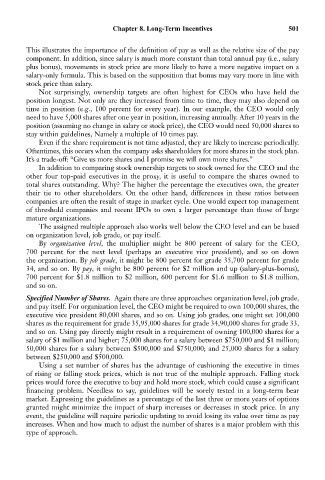Page 515 - Bruce Ellig - The Complete Guide to Executive Compensation (2007)
P. 515
Chapter 8. Long-Term Incentives 501
This illustrates the importance of the definition of pay as well as the relative size of the pay
component. In addition, since salary is much more constant than total annual pay (i.e., salary
plus bonus), movements in stock price are more likely to have a more negative impact on a
salary-only formula. This is based on the supposition that bonus may vary more in line with
stock price than salary.
Not surprisingly, ownership targets are often highest for CEOs who have held the
position longest. Not only are they increased from time to time, they may also depend on
time in position (e.g., 100 percent for every year). In our example, the CEO would only
need to have 5,000 shares after one year in position, increasing annually. After 10 years in the
position (assuming no change in salary or stock price), the CEO would need 50,000 shares to
stay within guidelines, Namely a multiple of 10 times pay.
Even if the share requirement is not time adjusted, they are likely to increase periodically.
Oftentimes, this occurs when the company asks shareholders for more shares in the stock plan.
It’s a trade-off: “Give us more shares and I promise we will own more shares.”
In addition to comparing stock ownership targets to stock owned for the CEO and the
other four top-paid executives in the proxy, it is useful to compare the shares owned to
total shares outstanding. Why? The higher the percentage the executives own, the greater
their tie to other shareholders. On the other hand, differences in these ratios between
companies are often the result of stage in market cycle. One would expect top management
of threshold companies and recent IPOs to own a larger percentage than those of large
mature organizations.
The assigned multiple approach also works well below the CEO level and can be based
on organization level, job grade, or pay itself.
By organization level, the multiplier might be 800 percent of salary for the CEO,
700 percent for the next level (perhaps an executive vice president), and so on down
the organization. By job grade, it might be 800 percent for grade 35,700 percent for grade
34, and so on. By pay, it might be 800 percent for $2 million and up (salary-plus-bonus),
700 percent for $1.8 million to $2 million, 600 percent for $1.6 million to $1.8 million,
and so on.
Specified Number of Shares. Again there are three approaches: organization level, job grade,
and pay itself. For organization level, the CEO might be required to own 100,000 shares, the
executive vice president 80,000 shares, and so on. Using job grades, one might set 100,000
shares as the requirement for grade 35,95,000 shares for grade 34,90,000 shares for grade 33,
and so on. Using pay directly might result in a requirement of owning 100,000 shares for a
salary of $1 million and higher; 75,000 shares for a salary between $750,000 and $1 million;
50,000 shares for a salary between $500,000 and $750,000; and 25,000 shares for a salary
between $250,000 and $500,000.
Using a set number of shares has the advantage of cushioning the executive in times
of rising or falling stock prices, which is not true of the multiple approach. Falling stock
prices would force the executive to buy and hold more stock, which could cause a significant
financing problem. Needless to say, guidelines will be sorely tested in a long-term bear
market. Expressing the guidelines as a percentage of the last three or more years of options
granted might minimize the impact of sharp increases or decreases in stock price. In any
event, the guideline will require periodic updating to avoid losing its value over time as pay
increases. When and how much to adjust the number of shares is a major problem with this
type of approach.

